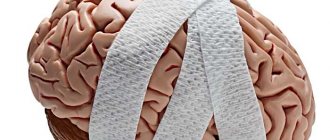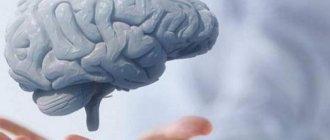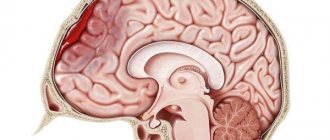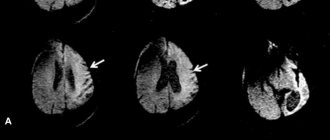© Author: A. Olesya Valerievna, candidate of medical sciences, practicing physician, teacher at a medical university, especially for SosudInfo.ru (about the authors)
Toxic encephalopathy occurs due to the negative impact on the brain of various toxins, usually of exogenous origin, which are able to penetrate the blood-brain barrier into neurons and cause their structural changes.
Toxic damage to nervous tissue can occur both acutely and chronically, but this pathology cannot be called rare, mainly because the poisons include alcohol and narcotic substances, which are abused by a significant number of people, more often young people.
The negative impact of neurotropic poisons is manifested by a variety of psychoneurological disorders, often the process is irreversible and progressive, contributing to persistent disability, and in severe cases, death of patients.
The brain is extremely sensitive to adverse external influences. Its cells suffer from a lack of oxygen and the action of a variety of chemicals that enter the blood through the respiratory, digestive and injection systems. Even small amounts of strong neurotropic poisons can cause severe destructive changes, which are sometimes impossible to combat.
The constant intake of small doses of toxins at work or at home leads to the development of chronic encephalopathy, the first signs of which are non-specific or completely invisible, which complicates timely diagnosis and delays the start of treatment until the advanced stage of brain damage.
As toxic products accumulate in the brain, dystrophic and necrotic processes in its cells increase, pockets of microinfarctions appear due to impaired microcirculation, and hypoxia worsens. The process is diffuse, but the most vulnerable parts of the central nervous system are the first to suffer - the subcortical nodes, brain stem, cerebellum, which explains the severity of the symptoms and the serious risk to the patient’s life.
Features of symptoms and the rate of progression of brain damage are usually associated with the nature of the toxin, its route of penetration and dose. In some cases, there are specific symptoms characteristic of one or another type of toxic encephalopathy, which make it possible to conduct targeted studies of blood composition to determine the causative factor.
Causes and types of toxic encephalopathy
Toxic encephalopathy occurs:
- Acute;
- Chronic.
In the case of acute pathology, symptoms increase quickly , a short time after the arrival of the neurotropic poison, while the dose is not always decisive. For example, acute alcoholic encephalopathy may occur after drinking a fairly large volume of ethanol, while the amount of methyl alcohol or ethylene glycol may be relatively small.
Chronic encephalopathy increases over weeks and months and is most often associated with the constant use of toxic substances in quantities that do not cause acute intoxication, but contribute to the accumulation of poison in neurons and their diffuse destruction.
Substances that provoke toxic encephalopathy penetrate from the external environment or are formed during metabolism in the patient’s body with pathology of the liver, endocrine system, and kidneys. Poisons can enter the body through contact with them at work, for example, at chemical industry facilities. In everyday life, ethyl alcohol becomes the most common neurotropic poison.
Chronic encephalopathy of toxic origin (ICD code 10 - G92) can be provoked by unfavorable environmental conditions when large industrial enterprises emit large amounts of toxic substances and production waste into the atmosphere. In such disadvantaged regions, residents are more likely to experience chronic headaches, early signs of vascular brain damage, and symptoms of oxygen deprivation. A certain risk is also created by man-made disasters accompanied by the release of neurotropic poisons into the atmosphere and water.
Potentially dangerous neurotropic poisons are:
- Ethanol;
- Narcotic substances, especially those produced in artisanal conditions;
- Methanol;
- Petroleum distillation products, hydrocarbons;
- Carbon monoxide;
- Pesticides used in agriculture;
- Some heavy metals (lead, mercury, etc.) and their compounds;
- Manganese;
- Certain medicines;
- Endogenous metabolic products are ketone bodies, uric acid salts, bilirubin.
Manganese (like alcoholic) encephalopathy is classified as a separate group due to the characteristics of its symptoms. This element can enter the body along with drugs manufactured at home, or less often in production (metallurgical industry, ore mining). The manifestations of manganese poisoning resemble Parkinson's disease.
Poisons of biological origin can also be neurotropic. For example, toxic encephalopathy can develop with infectious diseases such as botulism, diphtheria, and measles.
Treatment
Acute cases of hypertensive encephalopathy require urgent treatment, which is carried out primarily in intensive care units, where vital signs and electroencephalographic characteristics can be monitored. The first stage of treatment for such encephalopathy is to lower blood pressure with the help of medications. It should be remembered that the decrease in blood pressure is controlled in order to prevent the occurrence of vascular damage through their excessive contraction. After all, an excessive sharp decrease in blood pressure can lead to cerebral infarction, blindness and cardiac ischemia. Administration of diazoxide is effective for 80% of patients with hypertensive encephalopathy. This drug normalizes blood pressure within 3-5 minutes, and is effective for 6-18 hours. One of the advantages of diazoxide is that it does not cause drowsiness, i.e., it does not affect the patient's state of consciousness. The reflex tachycardia caused by this drug is its main disadvantage, which does not allow its use for the treatment of patients with coronary heart disease. Furosemide is administered simultaneously with diazoxide in order to increase both the antihypertensive effect and its duration. Hydralazine is also given intravenously or intramuscularly to lower blood pressure. Its action is similar to diazoxide, but it is less persistent. Another drug used to lower blood pressure is sodium nitroprusside, which is given into the body through an intravenous infusion. Nitroglycerin is sometimes used to lower blood pressure in patients with hypertensive encephalopathy. Another class of drugs used to lower blood pressure in hypertensive encephalopathy are ganglion blockers, which include labetalol, pentolinium, phentolamine and trimetaphan. These agents have a rapid effect and do not cause drowsiness. However, they can lead to serious side effects such as bowel and bladder atony. These drugs, with the exception of labetalol, are not used if hypertensive encephalopathy is associated with gestational eclampsia, because these drugs can harm the fetus. Reserpine, methyldopa and clonidine are used much less frequently in emergency cases of hypertension, because they act much more slowly (the effect of the drug begins 2-3 hours after administration) and, in addition, they affect the patient’s consciousness. Oral antihypertensive drugs are taken after the patient's first severe symptoms of the disorder disappear and intravenous injections are no longer necessary. In addition to antihypertensive medications, patients with seizures are usually prescribed anticonvulsants such as phenytoin. However, as a rule, antihypertensive medications are sufficient to treat neurological symptoms.
Symptoms of toxic encephalopathy
Encephalopathy of toxic origin has quite varied symptoms; some of the manifestations may indicate a specific toxic agent, but there are also general signs of damage to the nervous tissue that occur regardless of the type of active poison. These are considered:
- Excitement, restless behavior, feeling of fear;
- Euphoricity or aggression;
- Convulsive syndrome;
- Movement coordination disorder (more typical for the chronic form with damage to the cerebellar structures);
- Numbness of body parts;
- Dizziness, headaches;
- Phenomena of parkisonism;
- Vegetative dystonia with disturbances in thermoregulation, heart rhythm, and urination.
Often the effect of the neurotoxin begins with symptoms of agitation, and the patient may become aggressive and inappropriate in behavior and speech. As the concentration of poison in neurons increases, brain activity is inhibited, drowsiness appears, and a state of stupor and coma occurs. Reflexes and mobility are reduced, and with concomitant lesions of the spinal cord, sensitivity and functioning of the pelvic organs are also impaired.
Alcoholic encephalopathy
One of the most common causes of toxic damage to neurons is ethanol poisoning. Experts have identified this form of encephalopathy as an independent disease - alcoholic encephalopathy. The pathology acquires a chronic course with systematic, long-term abuse of alcohol, and the first symptoms become noticeable approximately three years after regular consumption of alcoholic beverages.
Ethanol can cause neuronal damage and loss of connections not only on its own, but also due to toxic metabolic products such as acetaldehyde. In addition to direct toxic effects, alcohol can cause microcirculation disorders and thrombus formation, irreversible changes in vascular walls, and multiple hemorrhages.
When consuming excessive doses of ethanol or poisoning with its surrogates, acute alcoholic encephalopathy develops, which can occur in the form of Gaye-Wernicke syndrome, alcoholic pseudoparalysis and other forms of pathology.
Symptoms of toxic encephalopathy in alcoholism include:
- Increasing weakness, constant feeling of fatigue;
- Weight loss;
- Dizziness and cranialgia;
- Digestive disorders in the form of unstable stools, vomiting;
- Insomnia, nightmares;
- Sweating, tachycardia and other rhythm disorders.
Patients lose weight, the skin becomes pale and then bluish, with a pronounced vascular network on the face, swelling and puffiness of the face are characteristic. Neurological symptoms consist of impaired coordination, instability, tremor of the limbs, lips, and paresthesia.
Mental changes are very characteristic of alcoholic encephalopathy. Patients may be aggressive or apathetic, prone to depression, and emotionally labile. Hallucinations are threatening, sleep disturbance progresses. Intelligence and ability to perform mental work are significantly reduced.
Gaye-Wernicke encephalopathy is considered the most severe form of alcoholic brain damage, when only 2 weeks pass from the first signs of pathology to the death of the patient. It manifests itself as delirium with hallucinations, which is replaced by complete lethargy and immobility.
Patients are inadequate and unavailable for contact, exhausted, swollen, and have pronounced neurological symptoms in the form of paresis and paralysis, hyperkinesis. Characterized by increased body temperature, rapid pulse and breathing, and hypotension. Convulsive seizures of a generalized nature are not uncommon.
Coma is caused by progressive cerebral edema and widespread hemorrhages in the middle and intermediate parts of the brain, while consciousness is completely lost and the functioning of vital organs is seriously impaired. The addition of secondary infections increases the risk of death.
The outcome of acute encephalopathy of alcoholic origin can be a persistent psychoorganic syndrome with irreversible brain dysfunction, loss of ability to work and self-care skills.
brain changes in alcoholic toxic encephalopathy
Forms of the disease
There are different forms of this disease. Among them, there are those that occur very often, and there are those that appear less frequently, but all these varieties have one thing in common: mental disorders are combined with systemic neurological and somatic disorders.
The risk group includes men who are moderately or severely dependent on alcohol, who often experience heavy drinking periods, who drink not alcohol itself, but its surrogates, and also those who have already fallen into a state of alcoholic delirium.
Types of alcoholic encephalopathy
There are two types of this disease, which are observed very often in people with alcohol dependence:
- Acute encephalopathy. In this form, due to the toxic effect of ethyl alcohol on the body, the central nervous system is affected. In this case, the mind becomes cloudy, hallucinations are observed, and an amental state of personality may even arise. There are several forms of acute encephalopathy: hemorrhagic polyencephalitis, mitigated acute encephalopathy, fulminant encephalopathy;
- Chronic type of encephalopathy. With this type, organic disorders of the central nervous system occur at the chemical and cellular levels. Among them are Korsakoff's syndrome and alcoholic pseudoparalysis.
There are also other varieties, but they are much less common and sometimes are not even classified as a separate disease.
Get advice anonymously and free of charge
Our specialist will call you within 5 minutes, leave a request
Manganese poisoning
Manganese has a toxic effect primarily on the subcortical nerve centers and the vascular network of the brain, and poisoning is more often recorded during ore mining and processing, and during the production of alloys and electrodes. Symptoms of poisoning are:
- Lethargy, drowsiness;
- Decreased muscle tone;
- Vague pain in the limbs;
- Decreased intellectual abilities - memory and writing disorders;
- Apathy, depression.
In severe cases, widening of the palpebral fissures, tremor of the tongue and signs of parkinsonism, inadequate emotional reactions in the form of laughter or tearfulness can be observed. These changes are organic in nature and irreversible, therefore, at the first signs of manganese poisoning, the patient is isolated from contact with the metal.
The clinic distinguishes three degrees (stages) of manganese encephalopathy. At the first stage, asthenia, weakness, a feeling of drowsiness, increased blood pressure, decreased muscle tone, pain and paresthesia in the legs and arms are observed. At the second stage, the listed symptoms intensify, intelligence is impaired, and polyneuropathy increases. The third stage is characterized by disturbances in the motor sphere, gait, and speech. The patient loses self-criticism, emotional instability, violent laughter or crying appears.
Encephalopathy due to lead poisoning
Lead poisoning occurs most often when lead dust is inhaled; less often, the toxin is ingested through the mouth. The following symptoms are characteristic:
- metallic taste in mouth
severe cramping pain in the abdominal area (due to contraction of intestinal smooth muscles);
- purple shade of gums;
- sweetish metallic taste in the mouth;
- nausea and vomiting;
- profuse salivation.
In case of severe poisoning, the peripheral nervous system is affected (lead polyneuritis, paralysis).
Poisoning with heavy metals, medications and toxic vapors
With mercury encephalopathy, hyperkinesis clearly manifests itself, and mental disorders progress. When mercury enters the digestive organs, severe abdominal pain, vomiting, and bloody diarrhea occur. The initial degree of poisoning occurs like autonomic dysfunction and neurasthenic disorder. Patients complain of irritability, poor sleep, headaches, rapid pulse, and increased sweating. Disorders of the function of endocrine organs are characteristic.
With acute mercury intoxication, pain in the head intensifies, sleep disappears, and vegetative symptoms increase - cardialgia, tachycardia, pressure fluctuations. The progression of poisoning leads to mental disorders.
When lead acts on neurons, a characteristic metallic sweet taste in the mouth, salivation, vomiting, abdominal pain, constipation, and flatulence appear. There are also cranialgia, mental disorders, pathology of breathing and heartbeat. Complications of lead intoxication include polyneuritis of toxic origin, paralysis and paresis.
Carbon disulfide poisoning occurs in chemical and textile industries, and in agriculture when using insecticides. This compound causes autonomic disorders and disorders of nervous regulation. In the clinic, mental disorders, autonomic dysfunction, polyneuropathy, and cerebral asthenia are possible. In severe cases, coma occurs.
With chronic long-term exposure to poison, organic brain damage develops, various hallucinations appear, intelligence is lost, depression and parkinsonism increase, and hypertension becomes permanent.
Gasoline vapors when inhaled cause poisoning and signs of encephalopathy. Characterized by psychoorganic syndrome, increased convulsive readiness, vascular dystonia, emotional lability, anxiety, sleep disturbances.
Arsenic exposure provokes diffuse degeneration of neurons both in the brain and in peripheral nerve trunks, while polyneuropathy comes to the fore in the clinical picture of the disease. Characterized by burning pain and weakness in the limbs, trophic disorders in the skin, atrophic changes in the muscles.
Drug-induced encephalopathy occurs with an overdose of aspirin-containing drugs, bromine, antipsychotics, sleeping pills and even non-steroidal anti-inflammatory drugs. It is manifested by weakness, headache, visual disturbances, speech, breathing, vomiting, mental disorders - agitation, aggression or apathy, drowsiness.
Symptoms
Depending on the substance that poisons the brain, the disease can manifest itself in different ways. But there are also general symptoms that indicate dysfunction of the nervous system. People in this condition suffer from:
- mental excitement;
- disturbances of mental reactions in the form of aggression, anxiety, fear, euphoria;
- failures in coordination of movements;
- epilepsy attacks or seizures;
- disturbances in muscle tone, as in Parkinson's disease;
- hypothalamic syndrome, manifested by vegetative-vascular, mental, thermoregulatory, neuroendocrine and neurotrophic disorders.
WE RECOMMEND SEEING: What is cephalalgia of the brain
First, there is a stage of excitation, which is replaced by a sharp depression of the nervous system. In this case, the patient’s reflexes decrease, consciousness and mobility are impaired, drowsiness is observed and a coma develops.
Gradually, the damage may spread to the spinal cord. In this case, sensitivity is partially impaired and the functioning of the pelvic organs is disrupted.
Manifestations depend on the location of the lesions. Based on this, different types of encephalopathy are distinguished.
Alcoholic
Toxic-dismetabolic encephalopathy most often manifests itself in the form of alcoholic encephalopathy. This is the most common brain lesion, which is classified as an independent disease.
Typically, the pathology develops in a chronic form as a result of regular consumption of ethyl or methyl alcohol. The first manifestations of the disease are observed after three years of daily drinking of alcoholic beverages or periodic long-term binges.
As a result of drinking alcohol, neurons and nerve connections between them are destroyed. Such damage is irreversible.
Regular consumption of alcohol provokes the appearance of multiple small focal hemorrhages and ruptures of small vessels. This causes degradation of brain structures. The situation is worsened by the fact that most patients do not recognize their problem and do not stop ensuring the flow of alcohol into the body.
Alcohol substitutes pose the greatest danger. They lead to acute poisoning of the body. The pathological condition of alcoholic encephalopathy occurs in the form of Gaye-Wernicke syndrome, alcoholic pseudoparalysis, Korsakoff's psychosis, and acute simulated form.
In general, with such lesions the patient suffers from:
- decreased performance, lethargy and fatigue;
- disruptions in the functioning of the digestive system, accompanied by heartburn, vomiting, diarrhea, constipation;
- dizziness and sleep disturbances;
- peeling or greasiness, changes in skin color to sallow;
- increased body temperature and increased sweating;
- speech disorders, spatial orientation, memory loss;
- loss of ability to move independently;
- epilepsy attacks.
If a person suffering from alcoholism develops encephalopathy, his hands and lips tremble, coordination is impaired, hallucinations and excessive aggressiveness bother him.
Manganese
Under the influence of manganese, the condition of the subcortical centers of the brain worsens. As a result of intoxication:
- the patient becomes lethargic and drowsy;
- muscle tone decreases;
- dull pain appears in the upper and lower extremities;
- Intellectual abilities and emotional background decrease.
Severe cases are accompanied by widening of the eyes, a grimace of a smile, unnatural laughter or crying, and trembling of the tongue.
Mercury
If the body has been exposed to mercury poisoning, then this condition can be determined by the presence of:
- painful sensations in the stomach, if the poison gets into the mouth, and in the chest;
- blue border on the surface of the gums;
- severe sweating and weakness;
- frequent heart contractions;
- insomnia.
There is also a symptom called mercury tremor, in which the limbs tremble. Poisoning is manifested by a contradictory mental state. If there is emotional upsurge and excitement, it is difficult to make even simple decisions.
Lead poisoning
Most often, intoxication occurs if a person inhales lead dust. The substance enters through the oral cavity in rare cases. Wherein:
- there is a metallic taste in the mouth;
- severe stomach pain;
- gums become purple;
- Nausea with vomiting is bothersome;
- A large amount of saliva is released.
If the poisoning is severe, damage to the peripheral nervous system occurs.
Gasoline poisoning
Gasoline intoxication leads to organic brain damage. At the same time, a person’s excitability increases, and seizures appear. Symptoms also appear in the form of:
- disruptions in psychomotor development;
- kidney liver pathologies;
- sleep disorders manifested by nightmares;
- muscle weakness.
The same signs may appear if a person is poisoned by a stain remover.
Arsenic
Under the influence of this substance, damage to the brain and spinal cord occurs, due to which:
- the patient has a severe headache;
- skin peels and hair falls out;
- weakness appears in the limbs;
- nails become covered with white stripes.
Drug poisoning
Toxic encephalopathy is a disease that can be caused by certain drugs if taken in large doses. Brain tissue and cells can be damaged by overuse:
- sleeping pills;
- barbiturates;
- narcotic painkillers;
- glucocorticoids;
- Indomethacin;
- salicylates and bromides.
WE RECOMMEND WATCHING: Are the consequences of a concussion dangerous?
As a result of poisoning, the vomiting center in the brain is excited, so vomiting and headache begin, and changes in the psychological state in the form of irritability and lethargy are also observed.
Sometimes speech, visual and respiratory functions are impaired.
Endogenous intoxications
Toxic-metabolic encephalopathy develops with disorders within the body that arise from congenital and acquired pathologies. In this case, it is important to determine what kind of disease caused the disorder in order to choose an effective method to eliminate the problem.
Endogenous intoxications
Another cause of toxic encephalopathy can be pathology of internal organs - the liver and kidneys. Such patients also have a variety of psychoneurological symptoms - behavior changes (aggressiveness, apathy, depression, etc.), intelligence decreases, untidiness and difficulties with self-care, paresthesia, disorders of the motor sphere and pelvic organ function appear. Severe degrees are accompanied by coma and cerebral edema.
A specific cause of toxic encephalopathy may be indicated by data on damage to a specific organ - liver enlargement, jaundice, bleeding, a characteristic liver or uremic odor, swelling and pallor, accumulation of fluid in the cavities, erosive lesions of the mucous membranes of the digestive and respiratory systems.
Due to the peculiarities of pathogenesis, course and therapy, these types of toxic encephalopathy are classified as pathologies of the corresponding organs and have separate headings in the International Classification of Diseases - hepatic or other unspecified encephalopathies (K72, G93.4).
Treatment and consequences of toxic encephalopathy
Organic damage to brain tissue due to the action of neurotropic poisons does not go away without leaving a trace. It is hardly possible to restore lost neurons, so changes in the psyche and neurological status are often permanent, leading to disability. Dangerous consequences are considered:
- Psychoorganic syndrome with loss of intellectual abilities;
- Coma and death;
- Bleeding in the brain;
- Irreversible mental disorders - hallucinations, depression, asthenoneurotic syndrome;
- Convulsive syndrome;
- Paralysis and polyneuropathy.
Treatment of toxic encephalopathy should be started as early as possible, at the very first symptoms of trouble. In addition, an integrated approach is important, taking into account the nature of the toxin, the degree of brain dysfunction, and the condition of the patient’s other organs.
In severe encephalopathy, tactics are aimed at stabilizing the condition; in all cases, infusion therapy and quickly limiting contact with a toxic substance are indicated. Patients are observed in toxicology or intensive care units, where there is every opportunity for intensive care.
The first action that should be taken is to stop contact with the neurotropic poison (for exogenous toxins). In the case of encephalopathy due to liver or kidney damage, it is impossible to immediately stop the action of toxic agents, so active detoxification therapy begins.
The basic principles of treatment of severe brain damage due to intoxication are:
- Conservative or surgical methods of detoxification, introduction of specific antidotes;
- Infusion of solutions and forced diuresis (has limitations in case of renal failure);
- The use of agents that enhance the breakdown of toxic substances - glucose, vitamin C, oxygen mixtures, sodium hypochloride);
- Transfusion of albumin, fresh frozen plasma to normalize the rheological properties of blood and hemostasis;
- Administration of glucocorticoids and diuretics to combat cerebral edema;
- The use of drugs that improve metabolic processes in the brain - cerebrolysin, nootropil, ATP, nicotinic acid, vitamins C and B;
- Anticonvulsant treatment - diazepam, magnesia, hexenal;
Removal of neurotropic poison is carried out by administering saline solutions into a vein, glucose, and accelerating urine excretion with diuretics. Cleansing enemas and gastric lavage are indicated to stop further absorption of the toxin. If necessary, hemodialysis, hemosorption and plasmapheresis are performed.
Symptomatic therapy includes the use of anticonvulsants (clonazepam, diazepam), tranquilizers, and antipsychotics for psychosis. To restore blood flow in the brain, vascular agents and antihypoxants (Cavinton, Nootropil, Actovegin, B vitamins, etc.) are indicated. If necessary, antihypertensive drugs, antiarrhythmics, and specific antidotes are prescribed if available.
Among conservative treatment methods, psychotherapy is of great importance. It is especially indicated for alcoholism and drug abuse, as well as depressive disorders. In addition, physiotherapy methods are used (massage, darsonval, medicinal baths).
Throughout the entire rehabilitation period, the patient takes multivitamin complexes, antioxidants, omega-3-based drugs, and nootropics. As indicated, he continues to take antidepressants and work with a psychotherapist.
The prognosis for encephalopathy of toxic origin is very serious, regardless of what poison caused it, since the damage is irreversible. The risk of developing cerebral edema, coma, and persistent psychoorganic syndrome requires extremely early initiation of treatment and dynamic monitoring of the patient after stabilization.











